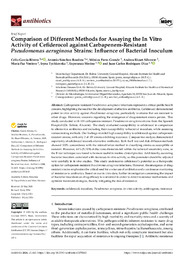Título :
Comparison of Different Methods for Assaying the In Vitro Activity of Cefiderocol against Carbapenem-Resistant Pseudomonas aeruginosa Strains: Influence of Bacterial Inoculum |
Autor :
García Rivera, Celia 
Sánchez Bautista, Antonia 
Parra Grande, Monica 
Ricart Silvestre, Andrea
Ventero, Maria Paz 
TYSHKOVSKA, IRYNA 
Merino de Lucas, Esperanza
RODRIGUEZ DIAZ, JUAN CARLOS  |
Editor :
MDPI |
Departamento:
Departamentos de la UMH::Producción Vegetal y Microbiología |
Fecha de publicación:
2024-07-18 |
URI :
https://hdl.handle.net/11000/35466 |
Resumen :
Carbapenem-resistant Pseudomonas aeruginosa infections represent a critical public health concern, highlighting the need for the development of effective antibiotics. Cefiderocol demonstrated potent in vitro activity against Pseudomonas aeruginosa, particularly in strains that are resistant to other drugs. However, concerns regarding the emergence of drug-resistant strains persist. This study, conducted with 109 carbapenem-resistant Pseudomonas aeruginosa strains from the Spanish Hospital (Dr. Balmis, Alicante). The study evaluated susceptibility to cefiderocol in comparison to alternative antibiotics and including their susceptibility to bacterial inoculum, while assessing various testing methods. Our findings revealed high susceptibility to cefiderocol against carbapenem-resistant strains, with only 2 of 109 strains exhibiting resistance. Comparative analysis demonstrated superiority of cefiderocol towards alternative antibiotics. Both the E-test and disk-diffusion methods showed 100% concordance with the microdilution method in classifying strains as susceptible or resistant. However, 4.6% (5/109) of disc zone diameters fell within the technical uncertainty zone, so the E-test technique was found to be more useful in routine clinical practice. Additionally, escalating bacterial inoculum correlated with decreases in vitro activity, so this parameter should be adjusted very carefully in in vivo studies. This study underscores cefiderocol’s potential as a therapeutic option for carbapenem-resistant Pseudomonas aeruginosa infections. However, the emergence of drug-resistant strains emphasizes the critical need for a wise use of antibiotics and a continuous monitoring of resistance to antibiotics. Based on our in vitro data, further investigation concerning the impact of bacterial inoculum on drug efficacy is warranted in order to detect resistance mechanisms and optimize treatment strategies, thereby mitigating the risk of resistance
|
Palabras clave/Materias:
Cefiderocol
Inoculum
Pseudomonas aeruginosa
In vitro activity
Antibiogram
Resistance |
Tipo de documento :
info:eu-repo/semantics/article |
Derechos de acceso:
info:eu-repo/semantics/openAccess
Attribution-NonCommercial-NoDerivatives 4.0 Internacional |
DOI :
https://doi.org/10.3390/antibiotics13070663 |
Publicado en:
Antibiotics 2024, 13(7), 663 |
Aparece en las colecciones:
Artículos - Producción vegetal y microbiología
|
 La licencia se describe como: Atribución-NonComercial-NoDerivada 4.0 Internacional.
La licencia se describe como: Atribución-NonComercial-NoDerivada 4.0 Internacional.
.png)
